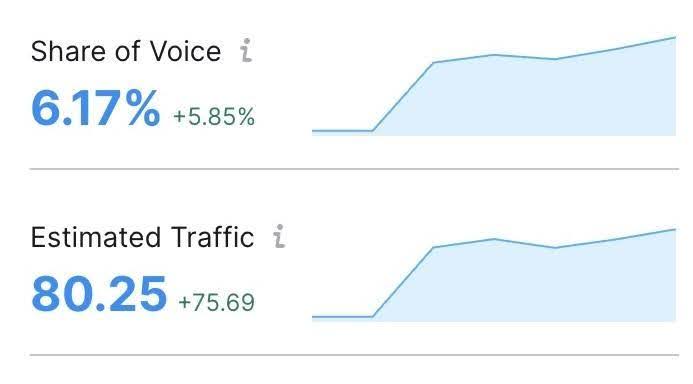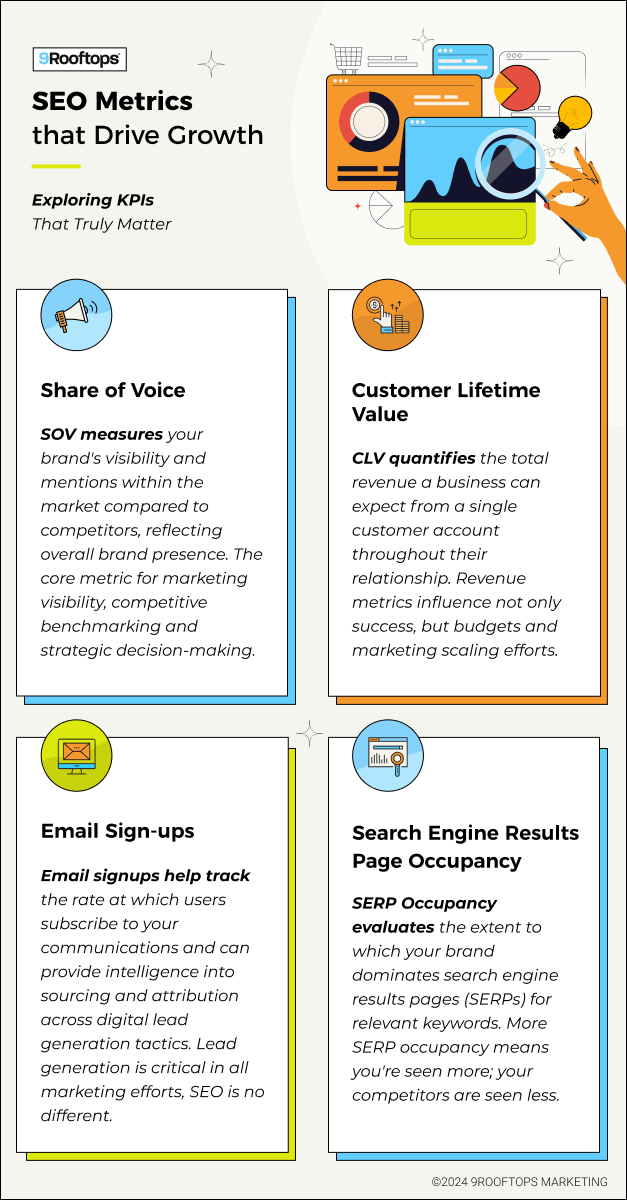
Measuring SEO Impact for Enterprise: Beyond Keyword Rankings
Dear Reader, Behold Your Search Engine Optimization (SEO) Measurement Problem (And Solutions)
There’s a pervasive problem in SEO at the heart of most failed campaigns. That problem? There’s little in the way of comprehensive, relevant measurement.
SEO ideas almost always begin in the meeting room where a few people decide “these keywords” win the game. Often, SEO strategy fails to evolve from that point.
The SEO strategist understands the company’s goals as “rank for these keywords,” and conceives a strategy that’s comprehensively weak, reactive and potentially unsustainable.
The problem: The measurement plan features only rankings.
So, what’s the solution?
We find our answer when we explore and expand Key Performance Indicators (KPIs) beyond typical SEO metrics.
Let’s highlight some enhanced SEO KPIs that help you better define your SEO strategy.
Market Share of Voice

If you’re an enterprise business and share of voice isn’t part of your SEO KPIs and reporting, you’re losing out.
One reason organic share of voice falls to the wayside is that many SEO strategists simply don’t understand it themselves.
Let’s break down this crucial SEO KPI.
Calculating share of voice involves analyzing your brand’s market share across search results and comparing those against competitors.
Let’s explore a working example.
Your company sells ice cream in New Orleans. You’re known for your vanilla and strawberry flavors. You want to understand your overall and local market share of voice for these two flavors.
To begin, you’d create two keyword lists, one for vanilla and one for strawberry.
Using SEMRush, we can import these two keyword groups into a project.
We’d tag all vanilla keywords as “vanilla” and all strawberry keywords as “strawberry.”
Now, we’d create two target locations: United States and New Orleans. We’d make sure these two keyword lists are reflected in each target.
So what’s the result?
In SEMRush, we can isolate each keyword target and determine organic market share of voice against anyone who ranks for those specific keywords. Moreover, we can insert our competitors and learn how much share of voice those specific competitors gobble up. We can now benchmark and track success.
Customer Lifetime Value (CLV)
We rarely find the lifetime value of a customer missing in paid media campaigns. So why then does CLV fall to the wayside for SEO campaigns?
One reason may be the myopic “keyword rankings” perspective.
Assessing the lifetime value of a customer using Google Analytics 4 (GA4) reporting via “user lifetime” helps you understand a core organic customer behavior.
Now, let’s consider the downside to this metric and propose a potential solution.
Measuring organic traffic CLV in GA4 is rather straightforward, however, it would take the traffic as a whole. The problem here is that most organic traffic is brand. Brand traffic will likely have an inflated CLV compared to non-brand; but even if it doesn’t, relative to the overall SEO campaign, it skews our data.
Solution: Separate Content Marketing and/or Pages.
The best strategy in growing non-brand keyword traffic is in creating content. Yes, blogs. Strategically, blogs appeal to informational intent keywords which tend to attract users less, or completely unfamiliar, with the brand.
This would help you dilute brand searches to a greater degree, leaving non-brand traffic in that specific CLV report.
You can also isolate your top-producing pages, find the pages that possess mostly non-brand keywords, and isolate those in a report.
In either scenario, you’d do this through a Pages and Screens report.
Both scenarios yield enough data to lend an understanding into how your SEO campaign efforts translate to the business’s bottom line.
Email Signups
I bet you didn’t expect email signups as an organic search KPI. That’s because it’s mostly an overlooked metric.
But overlooking email signups can be an egregious error in marketing strategy.
Organic search and email marketing create powerful advertising synergy. For starters, collecting customer touchpoints through organic traffic helps hedge bets against organic rankings turbulence.
But moreover, you can customize specific email opt-in forms for specific content marketing efforts. By breaking down what terms a piece of content ranks for, we can create a custom marketing automation journey with considerations to all as follows:
Form CTA: A/B tests various CTAs to increase email opt-ins from the get go.
Marketing Automation: Apply and prioritize both provided and observed product and content preferences to increase the relevancy and performance of your email marketing journeys.
SERP Feature Occupancy
With Google’s Search Generative Experience (SGE) incoming (it remains in beta), the future of search may be unsettling to some, but it’s becoming more clear to marketers.
Google will aim to resolve search problems with quick solutions.
Find an example of a Generative AI result following searching “how do I make vanilla ice cream?” below.

We quickly notice that Search Generative Experience results appear awfully similar to Featured Snippets, which we’ve come to recognize throughout Google’s search results.
Using SEMRush, we can understand which rankings offer crucial rich snippets such as recipes, site links and “people also ask”.
In the following example, I broke down the top two rankings for “vanilla ice cream.” The green arrows highlight instances of rich featured snippets.

As you can see, this particular search query offers a number of potential rich snippet opportunities.
With that said, Google’s Search Generative Experience remains in beta and isn’t displayed statistically. However, we can assume that Google’s trust in current rich snippets could translate into the Search Generative Experience environment.
Therefore, understanding your website’s overall contributions to rich snippets could shed light on what you might expect in the coming months and years in Search Generative Experience.
Obviously, I’ve only highlighted some big ticket KPIs. There are many organic search KPIs we should remain aware of. You can view the full list here.

Conclusion
In the dynamic and fast moving world of search engine marketing, focusing solely on keyword rankings is like trying to understand a story by reading only a few select pages. For enterprise companies aiming not just to compete but to trailblaze, an SEO measurement strategy should feature multi-dimensional and comprehensive components.
Embracing KPIs that illustrate growth such as SOV, CLB, email signups and dominating SERPs with rich snippets, transforms SEO from a simple numbers game to a strategic narrative.
In this narrative, you don’t merely track progress; instead, you highlight opportunities for growth that map your journey toward critical business goals.
We’re on the cusp of search innovations like Google’s Search Generative Experience. The stakes in organic traffic have never been higher.
If your enterprise business is still measuring SEO success by rankings alone, you’re missing out on valuable insights and overlooking vast potential in sustainable growth.
It may be time to broaden your search marketing horizon.
This is not an advertisement, and solely reflects the views and opinions of the author. This website and its commentaries are not designed to provide legal or other advice and you should not take, or refrain from taking, action based on its content. Additionally, unless otherwise stated, neither 9Rooftops nor the author is involved in, or responsible for, the marketing or promotional efforts of the individuals or entities discussed.

